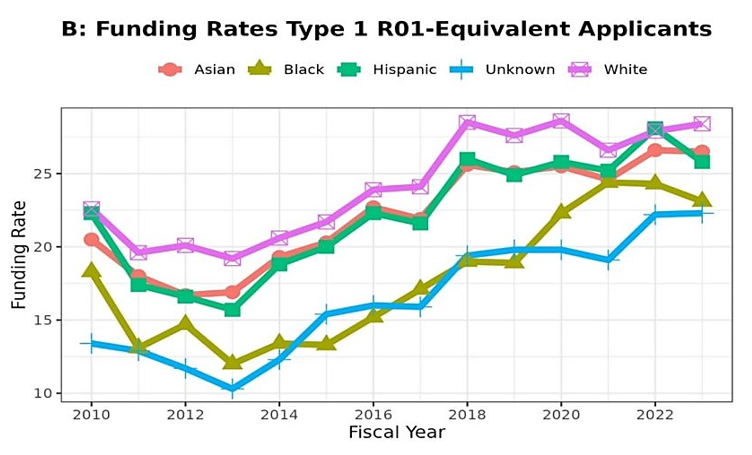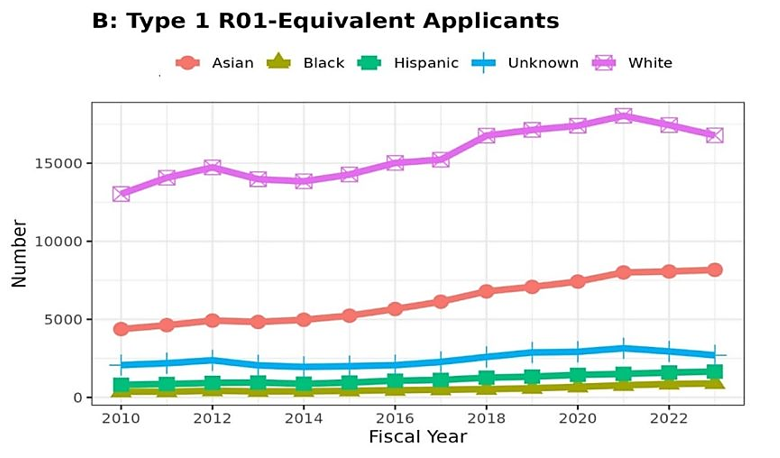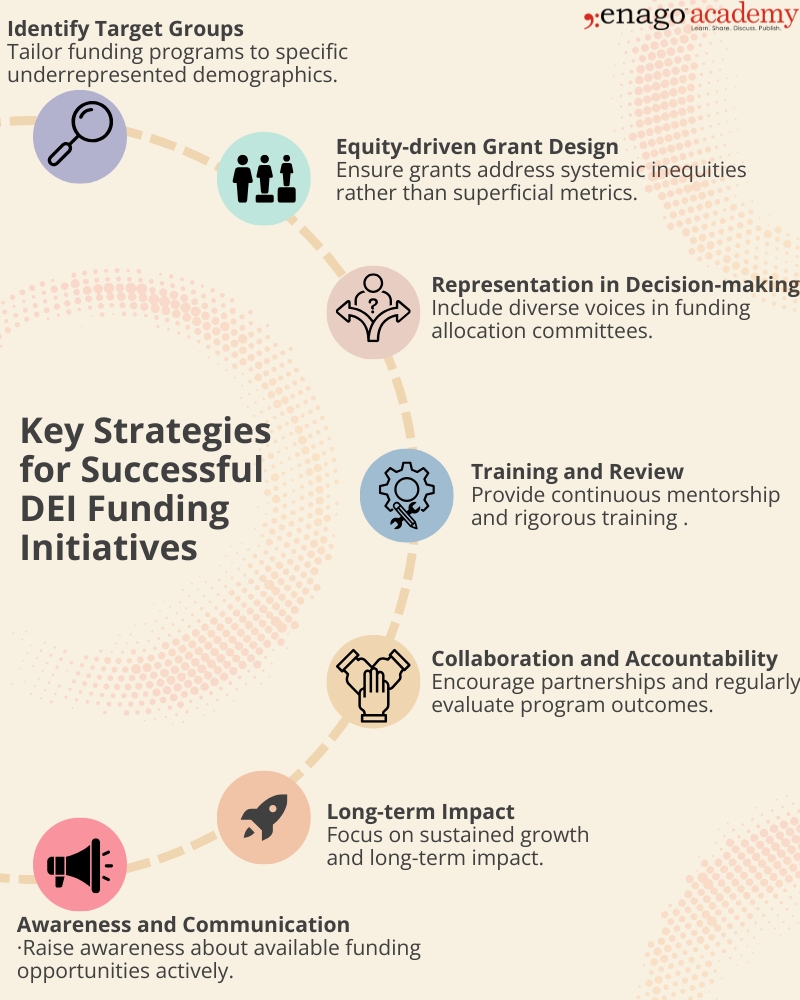Funding the Future: Driving diversity, equity, and inclusion in STEM research

The STEM (Science, Technology, Engineering, and Mathematics) industry has long struggled with underrepresentation on the basis of gender, ethnicity, physical disabilities, and mental health. Women account for only 35 % of the STEM graduates globally, and minorities face significant barriers, especially in leadership roles. A recent report from the NSF recorded that individuals from Hispanic origin represented only 18 % of the STEM workforce in 2021. The percentage contribution of Asian and Black individuals was further low. Similarly, researchers with disabilities and those experiencing mental health challenges often encounter systemic discrimination and a lack of institutional support. 28 % people with disabilities working in part time Science and Education sector expressed their willingness to work fulltime when compared to 15.5% of those without disabilities.
Recognizing these disparities, the Committee on Publication Ethics (COPE) has outlined four major recommendations to foster DEI:
Current Trends: Funding as a catalyst for representation
One of COPE’s core recommendations focuses on representational issues in the workforce. Funding targeted toward underrepresented researchers is required to foster DEI in STEM publication industry. Such initiatives address the immediate need for financial assistance but also develop sustainable practices that ensure long-term career development.
 Source: NIH Extramural Nexus
Source: NIH Extramural Nexus
Recent data suggests a steady increase in research funding globally. As shown in the above graph, the gaps in funding between White, Asian and Hispanic investigators have largely disappeared across years. Additionally, the NIH’s funding rates for diverse applicants rose by 5% in FY 2023 compared to the previous fiscal year. While this is exciting, there is also a pressing need to improve targeted funding to foster DEI and improve participation from underrepresented communities.
 Source: NIH Extramural Nexus
Source: NIH Extramural Nexus
This graph reiterates the above fact by showing the huge disparity in the number of applicants for NIH’s grants across different ethnicities. This calls for carefully designed funding opportunities that not only provide grants for underrepresented researchers but also but also actively engage with and empower them in a sustainable manner.
Designing such effective funding programs requires a multi-faceted approach.
Considerations for Effective DEI Funding
 To translate these considerations into action, several grant models and programs have been developed to effectively address DEI challenges. These initiatives not only embody the principles outlined above but also serve as examples that we can learn from.
To translate these considerations into action, several grant models and programs have been developed to effectively address DEI challenges. These initiatives not only embody the principles outlined above but also serve as examples that we can learn from.
Grant Models and Funding Programs Aimed at Improving DEI
-
NIH’s Diversity Supplements
- This targeted funding opportunity provides financial support to trainees, students, and researchers from underrepresented groups. This also empowers principal investigators with NIH funded projects to actively recruit and mentor individuals from diverse backgrounds.
- Core Principle and Goal: To foster inclusion and increase the participation of underrepresented groups in diverse research fields spanning from Biophysics to Pharmacology.
- Current Status: R-01 associated NIH’s diversity supplements boasts an 82.8 % annual growth rate from 2005 to 2020.
-
NSF ADVANCE Program
- ADVANCE program is a flagship initiative by the National Science Foundation (NSF) that funds innovative projects to address systemic barriers to gender equity in academia. This is particularly aimed at empowering institutional transformation efforts, leadership development for women faculty, and fostering partnerships to expand the impact of successful practices.
- Core Principle and Goal: To bring about sustainable, systemic change in embracing DEI in research institutions. This program also aims at supporting and advancing DEI initiatives globally.
- Current Status: By 2024, the program has built a diverse portfolio of projects with more than 170+ institutions worldwide.
-
Wellcome Trust’s Diversity Initiatives
- This is a series of funding schemes and programs by the Wellcome Trust designed to make biomedical research globally inclusive and empower researchers from low-income and marginalized communities.
- Core Principle and Goal: To reduce funding disparities and ensure equitable opportunities for researchers from diverse backgrounds, especially in low- and middle-income countries, to contribute to biomedical research.
- Current Status: Wellcome achieved its target of ensuring that at least 15% of its funding committees included Black, Asian, and minority ethnic communities. Their overall grant portfolio has also increased by 38% in 2021 since 2015/16.
-
Horizon Europe’s Gender Equality Plans
- This is an integral policy under the Horizon Europe research framework, requiring institutions applying for EU funding to implement and maintain Gender Equality Plans (GEPs). These plans include actions to address gender biases, improve work-life balance, promote gender equality in leadership, and integrate gender dimension into teaching content.
- Core Principle and Goal: To systematically integrate gender equality into research processes and institutional policies, promoting inclusive practices and breaking gender stereotypes in STEM fields. One major goal of this plan is to ensure increased involvement of women (at least 50%) in all Horizon Europe programmes.
- Current Status: In 2019, gender equality index was 67 out of 100. Horizon Europe has introduced EU awards for gender equality champions in the 2023 to empower those who are actively catalysing and taking its initiatives forward.
-
UKRI’s Inclusion Policies
- This is a comprehensive set of policies and funding strategies introduced by UK Research and Innovation (UKRI) to embed equity, diversity, and inclusion across all aspects of its operations. This includes dedicated funding streams, updated grant evaluation criteria to prioritize DEI efforts, and partnerships to foster inclusive research ecosystems.
- Core Principle and Goal: To create a diverse research environment where all researchers, regardless of background, are treated equally. UKRI has published detailed action plans for diverse research councils until the year 2025.
- Current Status: In 2023, around 47% of the UKRI workforce is shared by women. The overall percentage of women applicants for Innovate UK funds was also around 29% and the proportion of women supported by these funds is around 27%
-
African Academy of Sciences (AAS) Initiatives
- This is launched by the African Academy of Sciences (AAS) along with European Union to support the continent’s researchers and institutions to advance Science, Technology, and Innovation. Developing Excellence in Leadership, Training, and Science (DELTAS) Africa program and the Grand Challenges Africa scheme are some notable programs launched by the AAS.
- Core Principle and Goal: To promote African-led solutions to local and global challenges by empowering underrepresented groups, especially women and early-career researchers.
- Current Status: The continent saw a 135% increase in scientific publications from 2014 to 2022.
-
Canada’s Dimensions Charter
- This is a national framework launched by the Canadian government to widely adopt equity, diversity, and inclusion practices. Institutions signing this charter commit themselves to address systemic barriers and foster an inclusive research environment.
- Core Principle and Goal: To integrate DEI considerations into institutional policies, funding frameworks, and research practices, ensuring equitable access for underrepresented communities.
- Current Status: The charter received endorsement from over 143 institutions. However, the pilot program faced some funding issues during the pandemic and was not renewed afterwards.
-
India’s Vigyan Jyoti Program
- This is a government initiative launched by the Department of Science and Technology (DST) to empower women’s participation in STEM through targeted interventions. This is addressed through various initiatives — exposure visits to premier STEM institutions, mentorship programs, and scholarships for higher education to girls from underrepresented communities.
- Core Principle and Goal: To bridge the gender gap in STEM education and careers by encouraging and supporting girl students from class 9 through post-doctorate studies across 550 districts from 2020 to 2025.
- Current Status: As per the phase III reports, over 18082 girls students across 200 districts benefitted from this initiative.
-
Australian Research Council (ARC) DEI Framework
- This framework aims at integrating diversity, equity, and inclusion principles in all aspects of its research funding programs by empowering six key groups including disabled individuals and LGBTIQA+ (Lesbian, Gay, Bisexual, Trans/ Transgender, Intersex, Queer and Asexual) community.
- Core Principle and Goal: To create a more inclusive and equitable research culture in Australia by supporting underrepresented researchers and diversifying research leadership.
- Current Status: ARC has recently shared the updated diversity and inclusion framework and goals for 2024- 26.
These grant programs highlight the powerful role played by funding in fostering DEI and advancing inclusive practices in the STEM field. It is important to work synergistically with stakeholders across all levels to maximize this impact. Policy level changes in funding should start from the institute level and resonate through national and international forums. Equally crucial is raising awareness about these policies and grants to ensure that researchers, especially those from underrepresented groups, can leverage these opportunities to drive meaningful change.
How do you think these programs can be furthered to build a more inclusive STEM community? Share your ideas in the comment box below!













